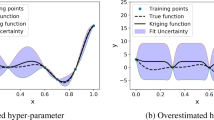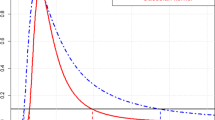Abstract
Selectively high-ordered kriging high dimension model representation (SH-K-HDMR) is proposed for efficient metamodeling of high-dimensional, expensive, blackbox (HEB) problems. SH-K-HDMR is a kind of cut HDMR, which selectively models high order interaction components. SH-K-HDMR starts with two groups of samples, which are for HDMR and model accuracy assessment, respectively. Variance of kriging prediction error is used for sequential sampling, and an interaction measure Hij… is suggested and used to choose high order interaction components of cut HDMR to be modeled. The group of samples for model accuracy assessment is also used for surrogate modeling at the end of the metamodeling process, to eliminate waste of samples. Performance of the SH-K-HDMR is compared to conventional metamodeling methods, namely full-dimension kriging and kriging-HDMR. The comparison study shows that SH-K-HDMR is superior when applied to high-dimensional and nonlinear engineering problems with strong interactions between variables.
Similar content being viewed by others
Abbreviations
- b, w :
-
Trend function weights and kriging weights
- d :
-
Number of relevant variables
- f :
-
Basis functions of trend \(\mu(\overrightarrow{x})\)
- g :
-
Component functions of HDMR
- H :
-
Measure of interaction
- i, j :
-
Indices
- N, m :
-
Number of samples and trend basis functions
- n ():
-
Number of set elements
- \(\overrightarrow{x}\) :
-
Design variables
- \(y(\overrightarrow{x}),\hat{y}(\overrightarrow{x})\) :
-
Target variable and its surrogate model
- \(Z(\overrightarrow{x})\) :
-
Random part of the target variable
- \(y(\Delta\overrightarrow{x})\) :
-
Variogram of \(Z(\overrightarrow{x})\)
- ε target :
-
Target accuracy
- λ :
-
Lagrange multipliers
- \(\mu(\overrightarrow{x})\) :
-
Trend part of target variable
- σ 2p :
-
Variance of kriging prediction error
- RMSE:
-
Root mean square error
- NRMSE:
-
Normalized root mean square error
- NME:
-
Normalized maximum error
References
S. Shan and G. G. Wang, Survey of modeling and optimization strategies to solve high-dimensional design problems with computationally-expensive black-box functions, Struct. Multidiscip. Optim., 41 (2010) 219–241.
K. Kang and I. Lee, Efficient high-dimensional metamodeling strategy using recursive decomposition coupled with sequential sampling method, Struct. Multidiscip. Optim., 63 (2021) 375–390.
J. E. Oakley and A. O’Hagan, Probabilistic sensitivity analysis of complex models: a Bayesian approach, J. R. Stat. Soc. B, 66 (2004) 751–769.
I. M. Sobol, Sensitivity estimates for nonlinear mathematical models, Math. Model. Comput. Exp., 1 (1993) 407–414.
H. Rabitz and O. F. Alis, General foundations of high-dimensional model representations, J. Math. Chem., 25 (1999) 197–233.
S. Shan and G. G. Wang, Metamodeling for high dimensional simulation-based design problems, J. Mech. Des., 132 (2010) 051009.
R. Jin, W. Chen and T. W. Simpson, Comparative studies of metamodeling techniques under multiple modelling criteria, Struct. Multidiscip. Optim., 23 (2001) 1–13.
L. Tang, H. Wang and G. Li, Advanced high strength steel springback optimization by projection-based heuristic global search algorithm, Mater. Des., 43 (2013) 426–437.
E. Li, F. Ye and H. Wang, Alternative kriging-HDMR optimization method with expected improvement sampling strategy, Eng. Comput., 34 (2017) 1807–1828.
H. Liu, S. Xu, Y. Ma, X. Chen and X. Wang, An adaptive Bayesian sequential sampling approach for global metamodeling, J. Mech. Des., 138 (2016) 011404.
A. Garbo and B. J. German, A model-independent adaptive sequential sampling technique based on response nonlinearity estimation, Struct. Multidiscip. Optim., 61 (2020) 1051–1069.
H. Wackernagel, Multivariable Geostatistics: An Introduction with Applications, Springer, Berlin (2003).
S. N. Lophaven, H. B. Nielsen and J. Sondergaard, Aspects of the Matlab Toolbox DACE, Informatics and Mathematical Modelling, Technical University of Denmark (2002).
T. Kim, D. Kim and D. Kim, Water impact of a surface-patterned disk, J. Fluid Mech., 915 (2021) A52.
M. D. Morris, T. J. Mitchell and D. Ylvisaker, Bayesian design and analysis of computer experiments: use of derivatives in surface prediction, Technometrics, 35 (1993) 243–255.
Q. Zhang and D. Chen, A model for the low cycle fatigue life prediction of discontinuously reinforced MMCs, Int. J. Fatigue, 27 (2005) 417–427.
Author information
Authors and Affiliations
Corresponding author
Additional information
Donghyun Kim received B.S. degree in Mechanical Engineering from KAIST. He is currently working in ADD, serving for his mandatory military service. His research interests include fluid mechanics, control engineering, and their applications in fluid machineries.
Ikjin Lee is an Associate Professor of Mechanical Engineering at KAIST. He received his Ph.D. in Mechanical Engineering at the University of Iowa. He joined KAIST in 2013. His research interests include system reliability analysis, design optimization, surrogate modeling, and system robustness analysis and design.
Rights and permissions
About this article
Cite this article
Kim, D., Lee, I. Efficient high-dimensional metamodeling strategy using selectively high-ordered kriging HDMR (SH-K-HDMR). J Mech Sci Technol 35, 5099–5105 (2021). https://doi.org/10.1007/s12206-021-1026-x
Received:
Revised:
Accepted:
Published:
Issue Date:
DOI: https://doi.org/10.1007/s12206-021-1026-x




